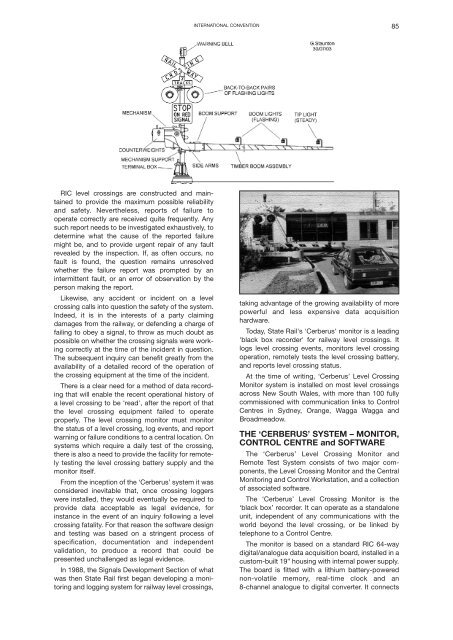Proceedings 2002/2003 - IRSE
Proceedings 2002/2003 - IRSE
Proceedings 2002/2003 - IRSE
You also want an ePaper? Increase the reach of your titles
YUMPU automatically turns print PDFs into web optimized ePapers that Google loves.
INTERNATIONAL CONVENTION 85<br />
RIC level crossings are constructed and maintained<br />
to provide the maximum possible reliability<br />
and safety. Nevertheless, reports of failure to<br />
operate correctly are received quite frequently. Any<br />
such report needs to be investigated exhaustively, to<br />
determine what the cause of the reported failure<br />
might be, and to provide urgent repair of any fault<br />
revealed by the inspection. If, as often occurs, no<br />
fault is found, the question remains unresolved<br />
whether the failure report was prompted by an<br />
intermittent fault, or an error of observation by the<br />
person making the report.<br />
Likewise, any accident or incident on a level<br />
crossing calls into question the safety of the system.<br />
Indeed, it is in the interests of a party claiming<br />
damages from the railway, or defending a charge of<br />
failing to obey a signal, to throw as much doubt as<br />
possible on whether the crossing signals were working<br />
correctly at the time of the incident in question.<br />
The subsequent inquiry can benefit greatly from the<br />
availability of a detailed record of the operation of<br />
the crossing equipment at the time of the incident.<br />
There is a clear need for a method of data recording<br />
that will enable the recent operational history of<br />
a level crossing to be ‘read', after the report of that<br />
the level crossing equipment failed to operate<br />
properly. The level crossing monitor must monitor<br />
the status of a level crossing, log events, and report<br />
warning or failure conditions to a central location. On<br />
systems which require a daily test of the crossing,<br />
there is also a need to provide the facility for remotely<br />
testing the level crossing battery supply and the<br />
monitor itself.<br />
From the inception of the ‘Cerberus’ system it was<br />
considered inevitable that, once crossing loggers<br />
were installed, they would eventually be required to<br />
provide data acceptable as legal evidence, for<br />
instance in the event of an inquiry following a level<br />
crossing fatality. For that reason the software design<br />
and testing was based on a stringent process of<br />
specification, documentation and independent<br />
validation, to produce a record that could be<br />
presented unchallenged as legal evidence.<br />
In 1988, the Signals Development Section of what<br />
was then State Rail first began developing a monitoring<br />
and logging system for railway level crossings,<br />
taking advantage of the growing availability of more<br />
powerful and less expensive data acquisition<br />
hardware.<br />
Today, State Rail's 'Cerberus' monitor is a leading<br />
'black box recorder' for railway level crossings. It<br />
logs level crossing events, monitors level crossing<br />
operation, remotely tests the level crossing battery,<br />
and reports level crossing status.<br />
At the time of writing, ‘Cerberus’ Level Crossing<br />
Monitor system is installed on most level crossings<br />
across New South Wales, with more than 100 fully<br />
commissioned with communication links to Control<br />
Centres in Sydney, Orange, Wagga Wagga and<br />
Broadmeadow.<br />
THE ‘CERBERUS’ SYSTEM – MONITOR,<br />
CONTROL CENTRE and SOFTWARE<br />
The ‘Cerberus’ Level Crossing Monitor and<br />
Remote Test System consists of two major components,<br />
the Level Crossing Monitor and the Central<br />
Monitoring and Control Workstation, and a collection<br />
of associated software.<br />
The ‘Cerberus’ Level Crossing Monitor is the<br />
‘black box’ recorder. It can operate as a standalone<br />
unit, independent of any communications with the<br />
world beyond the level crossing, or be linked by<br />
telephone to a Control Centre.<br />
The monitor is based on a standard RIC 64-way<br />
digital/analogue data acquisition board, installed in a<br />
custom-built 19” housing with internal power supply.<br />
The board is fitted with a lithium battery-powered<br />
non-volatile memory, real-time clock and an<br />
8-channel analogue to digital converter. It connects

















